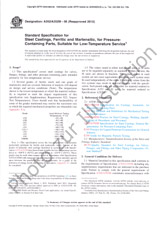Wir benötigen Ihre Einwilligung zur Verwendung der einzelnen Daten, damit Sie unter anderem Informationen zu Ihren Interessen einsehen können. Klicken Sie auf "OK", um Ihre Zustimmung zu erteilen.
ASTM D7277-16
Standard Test Method for Performance Testing of Articulating Concrete Block (ACB) Revetment Systems for Hydraulic Stability in Open Channel Flow
Automatische name übersetzung:
Standard Test Method for Performance-Tests von Artikulationsbetonblock (ACB) Revetment Systeme für hydraulische Stabilität in offenen Gerinne
NORM herausgegeben am 1.4.2016
Informationen über die Norm:
Bezeichnung normen: ASTM D7277-16
Anmerkung: UNGÜLTIG
Ausgabedatum normen: 1.4.2016
SKU: NS-636022
Zahl der Seiten: 7
Gewicht ca.: 21 g (0.05 Pfund)
Land: Amerikanische technische Norm
Kategorie: Technische Normen ASTM
Kategorie - ähnliche Normen:
Die Annotation des Normtextes ASTM D7277-16 :
Keywords:
articulating concrete block (ACB) revetment system, channel, channel lining, channel stability, erosion, erosion control, open-channel flow, permissible shear stress, permissible velocity, shear stress, velocity,, ICS Number Code 91.100.30 (Concrete and concrete products)
Ergänzende Informationen
| Significance and Use | ||||||||||||||||||||
|
5.1 An articulating concrete block revetment system is comprised of a matrix of individual concrete blocks placed together to form an erosion-resistant revetment with specific hydraulic performance characteristics. The system includes a filter layer compatible with the subsoil which allows infiltration and exfiltration to occur while providing particle retention. The filter layer may be comprised of a geotextile, properly graded granular media, or both. The concrete blocks within the matrix shall be dense and durable, and the matrix shall be flexible and porous. 5.2 ACB revetment system are used to provide erosion protection to underlying soil materials from the forces of flowing water. The term “articulating,” as used in this standard, implies the ability of individual concrete blocks of the system to conform to changes in subgrade while remaining interconnected by virtue of geometric interlock, cables, ropes, geotextiles, geogrids, or combination thereof. 5.3 The definition of ACB revetment system does not distinguish between interlocking and non-interlocking block geometries, between cable-tied and non-cable-tied systems, between vegetated and non-vegetated systems or between methods of manufacturing or placement. Furthermore, the definition does not restrict or limit the block size, shape, strength, or longevity; however, guidelines and recommendations regarding these factors are incorporated into this standard. Blocks are available in either open-cell or closed-cell configurations. |
||||||||||||||||||||
| 1. Scope | ||||||||||||||||||||
|
1.1 The purpose of this test method is to provide specifications for the hydraulic testing of full-scale articulating concrete block (ACB) revetment systems under controlled laboratory conditions for purposes of identifying stability performance in steep slope, high-velocity flows. The testing protocols, including system installation, test procedures, measurement techniques, analysis techniques, and reporting requirements are described in this test method. 1.2 The values stated in inch-pound units are to be regarded as standard. The values given in brackets are mathematical conversions to SI units that are provided for information only and are not considered standard. Reporting or use of units other than inch-pound shall not be considered non-conformance as long as the selected parameters described regarding flume construction by the inch-pound system used in this method are met as a minimum. 1.2.1 The gravitational system of inch-pound units is used when dealing with inch-pound units. In this system, the pound (lbf) represents a unit of force (weight), while the unit for mass is slugs. The rationalized slug unit is not given, unless dynamic (F = ma) calculations are involved. 1.3 All observed and calculated values shall conform to the guidelines for significant digits and rounding established in Practice D6026. 1.3.1 The procedures used to specify how data are collected, recorded and calculated in this Guide are regarded as the industry standard. In addition they are representative of the significant digits that generally be retained. The procedures used do not consider material variation, purpose of obtaining the data, special purpose studies or any considerations for the user’s objectives; and it is common practice to increase or reduce significant digits of reported data to be commensurate with these considerations. It is beyond the scope of this standard to consider significant digits used in analysis methods for engineering design. 1.4 This standard does not purport to address all of the safety concerns, if any, associated with its use. It is the responsibility of the user of this standard to establish appropriate safety and health practices and determine the applicability of regulatory limitations prior to use. Note 1: The quality of the result produced by this standard is
dependent on the competence of the personnel performing it and the
suitability of the equipment and facilities used. Agencies that
meet criteria of Practice D3740 are generally considered capable of
competent and objective testing. Users of this standard are
cautioned that compliance with Practice D3740 does not in itself assure reliable
results. Reliable results depend on many factors and Practice
D3740 provides a means of
evaluating some of these factors.
|
||||||||||||||||||||
| 2. Referenced Documents | ||||||||||||||||||||
|
Empfehlungen:
Aktualisierung der technischen Normen
Wollen Sie sich sicher sein, dass Sie nur die gültigen technischen Normen verwenden?
Wir bieten Ihnen eine Lösung, die Ihnen eine Monatsübersicht über die Aktualität der von Ihnen angewandten Normen sicher stellt.
Brauchen Sie mehr Informationen? Sehen Sie sich diese Seite an.




 Cookies
Cookies
